ISSN ONLINE(2319-8753)PRINT(2347-6710)
ISSN ONLINE(2319-8753)PRINT(2347-6710)
Pragati Jain1, Manisha Jain2, Paheli Singhal3
|
| Related article at Pubmed, Scholar Google |
Visit for more related articles at International Journal of Innovative Research in Science, Engineering and Technology
Rough Set approach has now been very widespread in the field of research. It has many applications almost in all areas related to business, banking, market research, information sciences, decision analysis, medical and many more. The paper presents the rough set approach as a tool to identify water leakage problem in automobiles. Decision and Conditional attributes play an important role in an information system. The approach generates sets of decision rules from data. Fundamentally the data representation with rough set theory is an information system that defines a discernibility matrix. Each entry consists of the set of attributes that can be used to discern between given objects. For every attribute an indiscernibility relation is defined. The basic idea of rough set is to construct approximation of sets using binary relations. The present paper explores the way of finding water leakage in front door cabin of an automobile by using minimal decision algorithm.
Keywords |
| Rough Set Theory, Minimal Decision Algorithm, Rule Generation, Water Leakage in Automobiles |
INTRODUCTION |
| George CantorâÃâ¬ÃŸs concept of Set Theory [1] has now become a foundational system of modern science and technology. Many researches are being done on verities of sets and their properties. The paper introduces Rough set theory and its application in analyzing data of information system of. This theory was introduced by Z. Pawlak [2] as a mathematical tool for data analysis. Automobile Sector has a significant role in the economy of any country. Vehicle used for goods transportation, infrastructure development and public transport. Run all around the country and round the clock in different weather conditions. Cabin is the prime part of commercial vehicle as it is important for driver to safe and comfortable driving in all conditions. Few years back driving comfort was not an important feature in commercial vehicles. Now a day it is the prime requirement of customer and government regularity authority. The safe operation of motor vehicle requires drivers should feel happy while sitting on the driver seat. The current cabin features in many vehicles will not meet the customer requirement & regulatory requirements such as Water leakage through joints & doors. In rainy season when our commercial vehicles are used; at that time driver has to drive the vehicle very carefully because force of rainy water and bed light to avoid accident but it is observed that water comes inside the cabin through both the doors (driver and co-driver) and front wind shield weather strip. |
II. ROUGH SETS PRELIMINARIES |
| Here we describe the notions related to the rough set theory [3]: |
| 1. Equivalence Relation: Let X be a set and let x, y and z be elements of X. An equivalence relation R on X is a relation on X such that: |
| Reflexive Property: xRx for all x in X. Symmetric Property: if xRy, then yRx. Transitive Property: if xRy and yRz, then xRz. |
2. Information system: |
| Let an information system T = (U, A, Va, fa) be a Decision system data, where i. U is a non-empty, finite set called the universe. ii. A is a non-empty finite set of attributes, C∪Dwhere C and D are conditional and decision attributes subsets respectively. iii. Vais called the value set or domain of the attribute „aâÃâ¬ÃŸ, where, a :U V a A a → ∀ ∈ . iv. a a f :U × A→V is the total decision function called the information function such that f ( x,a ) V a A, x U a ∈ ∀ ∈ ∀ ∈ The elements of U are objects, cases, states, observations [4]. The Attributes are interpreted as features, variables, characteristics conditions |
3. Indiscernibility Relation |
| The binary indiscernibility relation RB is an equivalence relation with any subset of attributes B⊆A defined as: R { (x, y) U U : a(x) a(y), a B } S = ∈ × = ∀ ∈ . The indiscernibility relation defines a partition in U. The family of all the equivalence classes of the relation RBis denoted by U | RB called B-elementary sets. Two other equivalence classes U | RCandU | RD, called condition and decision equivalence classes respectively, can also be defined [5]. |
4. R-Lower and R-Upper Approximation |
| Let S be an Information System, X be non-empty subset of U and for any subset X⊆U , the R-lower approximation and R-upper approximation of X in S are defined, respectively, by: R( X ) { x U : R ( X ) X φ B = ∈ ∩ ≠ and R( X ) { x U : R ( x ) X } B = ∈ ⊆ . The elements of R( X ) are all the elementary objects certainly belonging to X. The elements of R( X ) are at least one object belonging to X. In other words R( X ) is the largest union of the B-elementary sets included in X while R( X ) is the smallest union of the B-elementary sets containing X.[6] |
| The universe is divided into three regions: |
| i. The Boundary Region BN(X) is defined as: BN( X ) = RX -RX |
| ii. The Positive Region POS(X) is defined as: RX |
| iii. The Negative Region NEG(X) is defined as: U - RX |
5. Representation of the approximation sets |
| If R( X ) = R( X ) then, X is R-definable (the boundary set is empty). |
| If R( X )≠R( X ) then, X is Rough with respect to B. |
| 6. Decision Rules and Probabilistic Properties: Let C→Dis a decision rule in S that means IF C THEN D where C = {c1, c2, c3, …….cn} is the set of condition attribute and D ={ d1, d2, d3,………. Dm} is the set of decision attributes |
III. WATER LEAKAGE PROBLEM IN CABIN (FROM DOORS) |
| Water leakage problem is basically related to door gaps and door ring dimension which comes during joining of different sub assembly. |
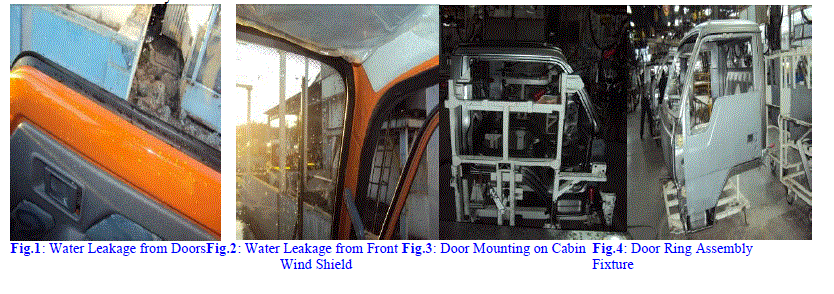 |
2.1 Door Gap: |
| Door gap is vital parameter for water leakage and door locking. Door ring is made at Main body assembly station where under body assembly, front end structure, rear end structure and roof fitment activity done. The gaps between door outer and door ring are called door outer gaps. Door outer gaps at 15 positions on each side (left hand and right hand side) of the cabin as shown in the figure we are only analyzing position1-3. |
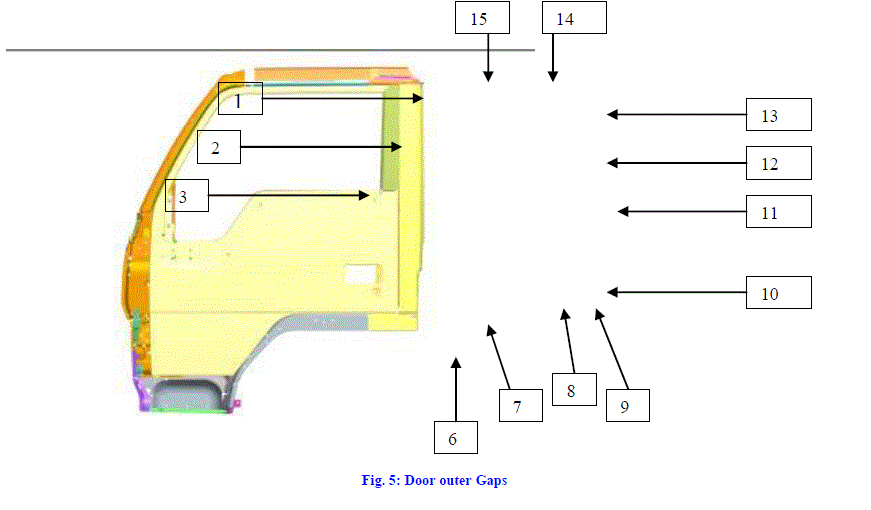 |
| Position 1 to 3: gaps between door sash to front pillar drip channel. Position 6 to 9: gaps between doors outer to fender assembly. Position 10 to 13: gaps between door to rear pillar assembly Position 14 to 15: gaps between door sash to roof side drip assembly. |
| Here, Positions 4 and 5 are not marked in the figure because it is a gap between corner panel and door not applicable for this paper and also not shown in the figure. |
IV. INFORMATION SYSTEM |
| The data was obtained from an Automobile Company. The data was obtained from an Automobile Company for the three positions of the front Cabin doors. Table 1 represents the information system while Table 2 represents the indiscernibility matrix of the given information. |
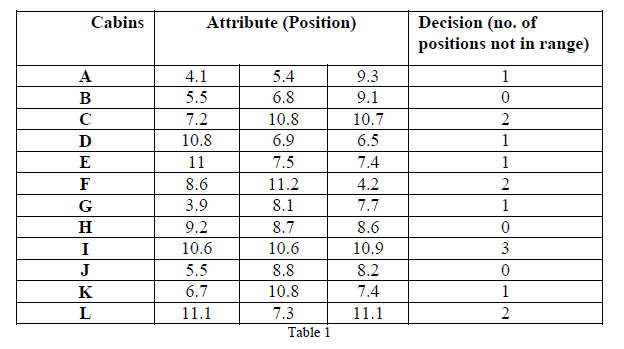 |
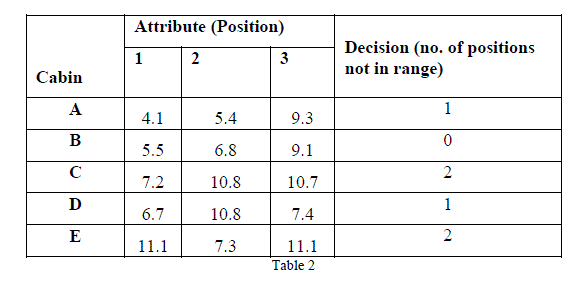 |
V. MINIMAL DECISION ALGORITHM AND RULE GENERATION |
| In the process of extracting a minimal decision algorithm, it is required to use trial & error to determined nondeterministic rule & make the decision table free from contradictions. In order to find insignificant conditional attributes in the diagnoses, a number of conditional attributes should be remove each time & decision table should be examined to make sure no contradiction has occurred. If any contradiction happens, it means that the removed class number is significant otherwise it is not significant in the analysis. Table 3 shows minimal decision algorithm [7]. |
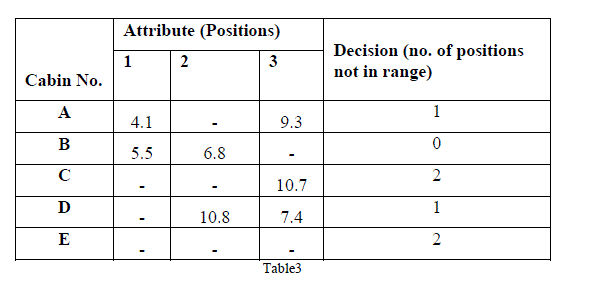 |
| The minimal decision algorithm can be described by rules (Table 4) such as “if conditional part, THEN, conclusive part[8] |
 |
VI. CONCLUSION |
| Rough set approach provides a tool to generate rule with the use of minimal decision algorithm through which the proper position of water leakage in automobiles can be identified. |
References |
|